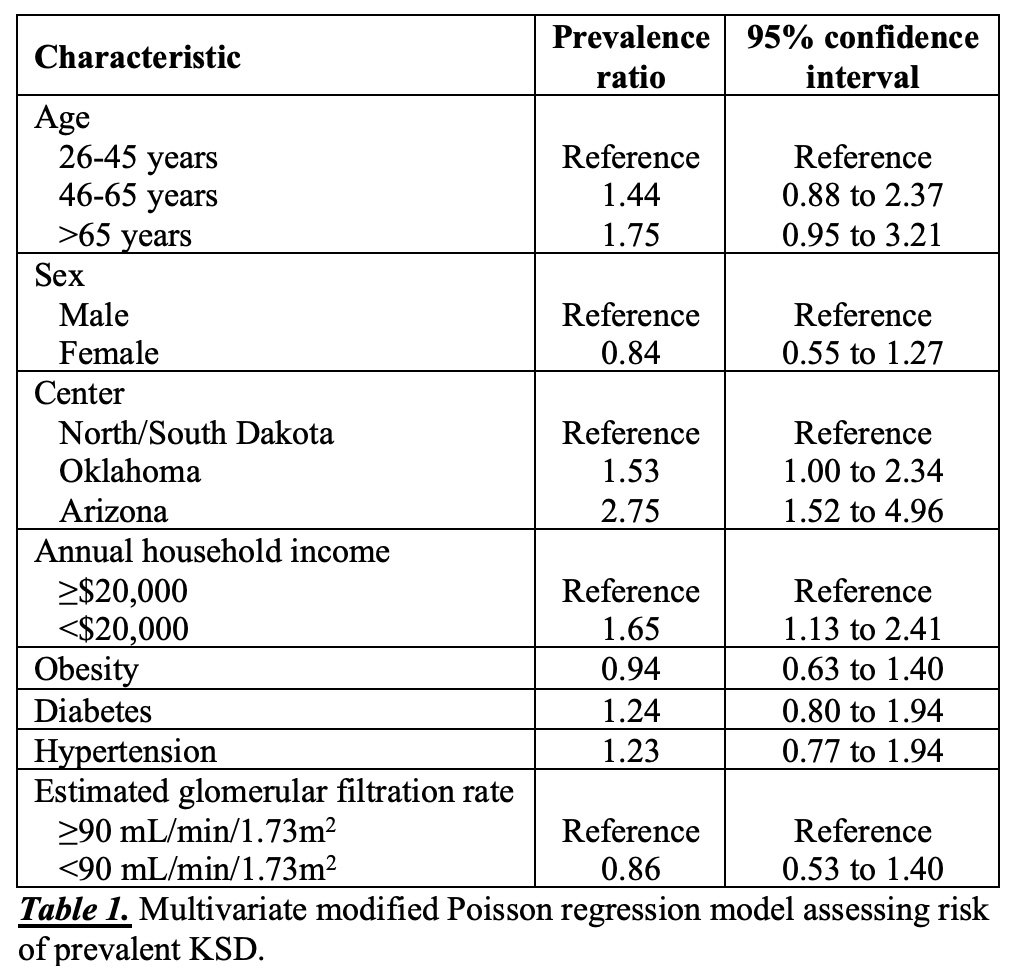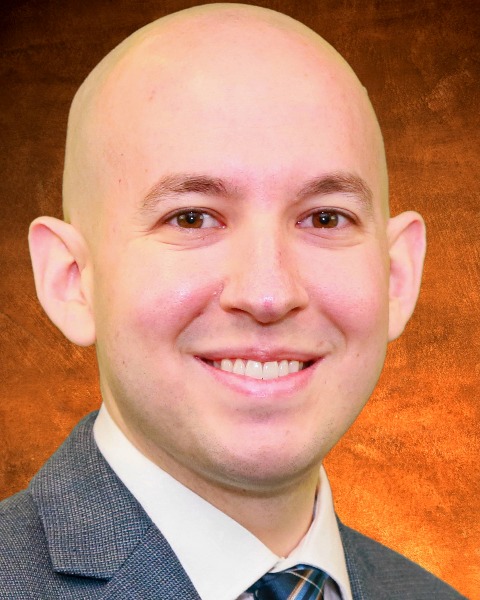Back
Introduction: The epidemiology of kidney stone disease (KSD) has not been well described in American Indian communities. We studied the prevalence of KSD in the Strong Heart Family Study, a large prospective cohort of American Indian adults.
Methods: Strong Heart Family Study participants are members of American Indian tribes from Arizona, Oklahoma, and North/South Dakota. Self-reported history of KSD was available from the Phase VI visit (2014-2018). Differences in characteristics of participants with and without KSD were determined using chi-square tests for categorical variables and independent t tests for continuous variables. Modified Poisson regression with robust variance estimation was used to examine associations between participant characteristics and prevalent KSD.
Results: Among 2,069 participants from the Phase VI visit (mean age 51.6 years, 789 [38.1%] male), 133 (6.4%) had a self-reported history of KSD. No significant difference in KSD prevalence was observed by sex (5.8% for males vs. 6.8% for females, p=0.4). Prevalence ratio estimates derived through modified Poisson regression are shown in Table 1. Residence in Oklahoma or Arizona was associated with greater KSD prevalence, compared to North/South Dakota. Annual household income <$20,000 was also associated with greater KSD prevalence, compared to =$20,000. Several established risk factors for KSD in the U.S. (obesity, diabetes, and hypertension) were not significantly associated with prevalent KSD in this study.
Conclusions: These findings suggest that there are meaningful socioeconomic risk factors for KSD in American Indian communities which require further investigation. SOURCE OF
Funding: The Strong Heart Study has been funded in whole or in part with federal funds from the National Heart, Lung, and Blood Institute, National Institute of Health, Department of Health and Human Services, under contract numbers 75N92019D00027, 75N92019D00028, 75N92019D00029, & 75N92019D00030. The study was previously supported by research grants: R01HL109315, R01HL109301, R01HL109284, R01HL109282, and R01HL109319 and by cooperative agreements: U01HL41642, U01HL41652, U01HL41654, U01HL65520, and U01HL65521. The content is solely the responsibility of the authors and does not necessarily represent the official views of the National Institutes of Health or the Indian Health Service (IHS).

Moderated Poster Session
Session: MP16: Stone Disease: Epidemiology & Evaluation I
MP16-17: Prevalence of Kidney Stone Disease Among American Indian Adults in the Strong Heart Family Study
Friday, April 28, 2023
1:00 PM – 3:00 PM CST
Location: S405

Joseph J. Crivelli, MD
University of Alabama at Birmingham School of Medicine
Poster Presenter(s)
Introduction: The epidemiology of kidney stone disease (KSD) has not been well described in American Indian communities. We studied the prevalence of KSD in the Strong Heart Family Study, a large prospective cohort of American Indian adults.
Methods: Strong Heart Family Study participants are members of American Indian tribes from Arizona, Oklahoma, and North/South Dakota. Self-reported history of KSD was available from the Phase VI visit (2014-2018). Differences in characteristics of participants with and without KSD were determined using chi-square tests for categorical variables and independent t tests for continuous variables. Modified Poisson regression with robust variance estimation was used to examine associations between participant characteristics and prevalent KSD.
Results: Among 2,069 participants from the Phase VI visit (mean age 51.6 years, 789 [38.1%] male), 133 (6.4%) had a self-reported history of KSD. No significant difference in KSD prevalence was observed by sex (5.8% for males vs. 6.8% for females, p=0.4). Prevalence ratio estimates derived through modified Poisson regression are shown in Table 1. Residence in Oklahoma or Arizona was associated with greater KSD prevalence, compared to North/South Dakota. Annual household income <$20,000 was also associated with greater KSD prevalence, compared to =$20,000. Several established risk factors for KSD in the U.S. (obesity, diabetes, and hypertension) were not significantly associated with prevalent KSD in this study.
Conclusions: These findings suggest that there are meaningful socioeconomic risk factors for KSD in American Indian communities which require further investigation. SOURCE OF
Funding: The Strong Heart Study has been funded in whole or in part with federal funds from the National Heart, Lung, and Blood Institute, National Institute of Health, Department of Health and Human Services, under contract numbers 75N92019D00027, 75N92019D00028, 75N92019D00029, & 75N92019D00030. The study was previously supported by research grants: R01HL109315, R01HL109301, R01HL109284, R01HL109282, and R01HL109319 and by cooperative agreements: U01HL41642, U01HL41652, U01HL41654, U01HL65520, and U01HL65521. The content is solely the responsibility of the authors and does not necessarily represent the official views of the National Institutes of Health or the Indian Health Service (IHS).

